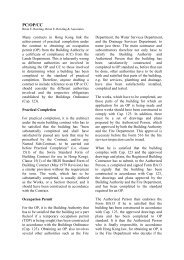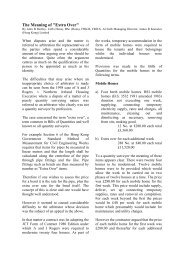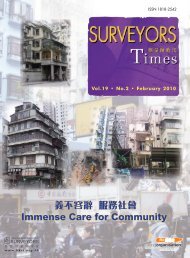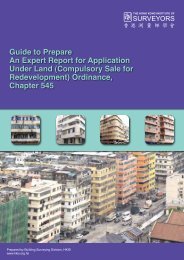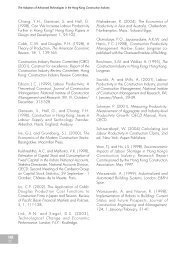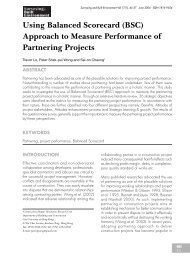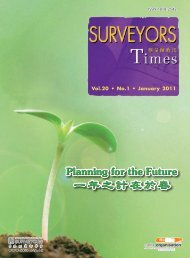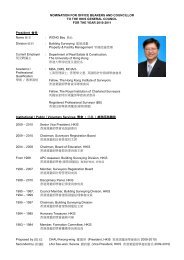Special issue to commemorate the 70th Anniversary of the Battle of ...
Special issue to commemorate the 70th Anniversary of the Battle of ...
Special issue to commemorate the 70th Anniversary of the Battle of ...
You also want an ePaper? Increase the reach of your titles
YUMPU automatically turns print PDFs into web optimized ePapers that Google loves.
Decoding <strong>the</strong> Enigma <strong>of</strong> <strong>the</strong> Fall <strong>of</strong> <strong>the</strong> Shing Mun Redoubt Using Line <strong>of</strong> Sight Analysis<br />
or MicroSurveyCAD 2009.<br />
In generating <strong>the</strong> Lines <strong>of</strong> Sight/Fire covers, <strong>the</strong><br />
commercial GIS s<strong>of</strong>tware, “ESRI ArcGIS,” with its<br />
extension package, viz., 3D spatial analysis, was<br />
used <strong>to</strong> construct a three-dimensional view <strong>of</strong> <strong>the</strong><br />
interpolated surface. There was, indeed, o<strong>the</strong>r GIS<br />
s<strong>of</strong>tware (e.g. Global Mapper; MicroDEM; ERDAS<br />
Imagine, and IDRISI) on <strong>the</strong> market that was also<br />
capable <strong>of</strong> generating 3D views and contained a similar<br />
analyzing function, but we selected ArcGIS <strong>to</strong> conduct<br />
<strong>the</strong> analysis for <strong>the</strong> following reasons:<br />
• It was probably <strong>the</strong> most common GIS s<strong>of</strong>tware<br />
used in Hong Kong, if not <strong>the</strong> world. Many GIS<br />
and land-related pr<strong>of</strong>essionals have used <strong>the</strong><br />
s<strong>of</strong>tware since <strong>the</strong>ir training/studying periods.<br />
• In light <strong>of</strong> its popularity in <strong>the</strong> industry, <strong>the</strong><br />
s<strong>of</strong>tware’s problems <strong>of</strong> data conversion, data<br />
format, and data compatibility could be minimized.<br />
• It contains many user-friendly, built-in functions<br />
that can be used <strong>to</strong> generalize results.<br />
• O<strong>the</strong>r GIS s<strong>of</strong>tware contained different limitations<br />
in building up <strong>the</strong> surface model.<br />
After all <strong>the</strong> surveyed details were generated and<br />
plotted in Au<strong>to</strong>CAD format, <strong>the</strong> data was <strong>the</strong>n, layer by<br />
layer, incorporated and geo-referenced in<strong>to</strong> <strong>the</strong> ArcMap<br />
with <strong>the</strong> B1000 as base maps.<br />
By abstracting <strong>the</strong> digital con<strong>to</strong>ur information, as<br />
contained in <strong>the</strong> base maps, a Triangular Irregular<br />
Networks (TINs) model was <strong>the</strong>n built <strong>to</strong> create <strong>the</strong> 3D<br />
terrain model <strong>of</strong> <strong>the</strong> Shing Mun Redoubt. TINs, which<br />
are digital geographic data in <strong>the</strong> form <strong>of</strong> a vec<strong>to</strong>r base,<br />
were established by triangulating a set <strong>of</strong> vertices.<br />
These vertices were connected with a series <strong>of</strong> edges <strong>to</strong><br />
form a network <strong>of</strong> triangles.<br />
Upon completing <strong>the</strong> TIN model, <strong>the</strong> elevation values<br />
for any location on <strong>the</strong> TIN surface could <strong>the</strong>n be<br />
interpolated using <strong>the</strong> values <strong>of</strong> <strong>the</strong> triangles’ nodes.<br />
In ArcMap, some built-in <strong>to</strong>ols could be used <strong>to</strong><br />
analyse <strong>the</strong> visibility <strong>of</strong> <strong>the</strong> parts <strong>of</strong> <strong>the</strong> resulting model<br />
surfaces. In this project, two major <strong>to</strong>ols, viz, <strong>the</strong> Line<br />
<strong>of</strong> Sight and Viewshed, were used:<br />
• The effective observation range <strong>of</strong> <strong>the</strong> MG was<br />
600m at all angles.<br />
• There was an average plant height <strong>of</strong> one metre at<br />
<strong>the</strong> Shing Mun Redoubt in December 1941.<br />
• There was no material change in <strong>the</strong> natural<br />
<strong>to</strong>pography between December 1941 and <strong>the</strong><br />
present except that which was already reflected in<br />
<strong>the</strong> survey plan.<br />
• The heights <strong>of</strong> <strong>the</strong> observers at <strong>the</strong> PBs and OP<br />
were 1.2m above <strong>the</strong> floor level.<br />
• The heights <strong>of</strong> <strong>the</strong> observers at <strong>the</strong> concrete firing<br />
trenches were 0.7m above <strong>the</strong> floor level.<br />
• The heights <strong>of</strong> <strong>the</strong> observers at <strong>the</strong> dam were 1.2m<br />
above <strong>the</strong> floor level.<br />
• The targets at <strong>the</strong> PBs and OP were one metre<br />
above <strong>the</strong> floor level.<br />
• The targets at <strong>the</strong> concrete firing trenches were 0.5m<br />
above <strong>the</strong> floor level.<br />
• The targets at <strong>the</strong> dam were at <strong>the</strong> ground level.<br />
• The average refraction fac<strong>to</strong>r was applicable.<br />
• The Earth’s curvature was negligible.<br />
The key findings are shown in Figures 2 <strong>to</strong> 5 and<br />
Table 2.<br />
Figure 2 shows <strong>the</strong> horizontal surveyed layout <strong>of</strong> <strong>the</strong><br />
entire Shing Mun Redoubt as it existed in Winter 2008<br />
with <strong>the</strong> names <strong>of</strong> <strong>the</strong> tunnels (which were actually<br />
inscribed on <strong>the</strong> walls <strong>of</strong> <strong>the</strong> tunnels and <strong>the</strong> open<br />
trenches, <strong>to</strong> which numbers T1 <strong>to</strong> T9 were assigned by<br />
<strong>the</strong> authors for ease <strong>of</strong> reference. The question as <strong>to</strong><br />
whe<strong>the</strong>r <strong>the</strong>re was one or are two systems <strong>of</strong> tunnels<br />
has been answered: <strong>the</strong>re were two separate systems.<br />
This shows that <strong>the</strong> tunnels were deliberately not built<br />
in straight lines, but in a zig-zag manner with varying<br />
widths. This was certainly a design feature <strong>to</strong> prevent<br />
<strong>the</strong> enemy’s ‘enfilade fire’ from easily shooting inside<br />
<strong>the</strong> tunnel. During <strong>the</strong> survey, we identified from aerial<br />
pho<strong>to</strong>s and measured a concrete bunker or block house,<br />
now in ruins, very close <strong>to</strong> Jubilee Dam. Marked on<br />
our maps as “Position X”, this site had never been<br />
reported, but would have altered <strong>the</strong> course <strong>of</strong> <strong>the</strong><br />
fight for <strong>the</strong> Redoubt had it been manned as a forward<br />
post with machine guns. This post covered <strong>the</strong> entire<br />
Jubilee Dam and <strong>the</strong> slopes <strong>of</strong> Needle Hill descending<br />
<strong>to</strong> <strong>the</strong> dam.<br />
• The Line <strong>of</strong> Sight <strong>to</strong>ol identifies whe<strong>the</strong>r or not one<br />
location is visible from ano<strong>the</strong>r and whe<strong>the</strong>r or not<br />
<strong>the</strong> intervening locations along a line between <strong>the</strong><br />
two locations are visible (ESRI, 2006).<br />
• The Viewshed <strong>to</strong>ol can be used <strong>to</strong> find <strong>the</strong> places<br />
that can be seen from one or more observation<br />
points or lines. It calculates for each cell <strong>of</strong> a<br />
raster surface and codes <strong>the</strong>m <strong>to</strong> indicate if <strong>the</strong>y are<br />
visible (ESRI, 2006).<br />
For analysing firing arcs and lines <strong>of</strong> sights, we made<br />
some basic technical assumptions:<br />
• The elevation and depression observation angles <strong>of</strong><br />
<strong>the</strong> Vickers Machine Gun (MG) were 20 degrees<br />
and 30 degrees, respectively.<br />
SBE<br />
34




